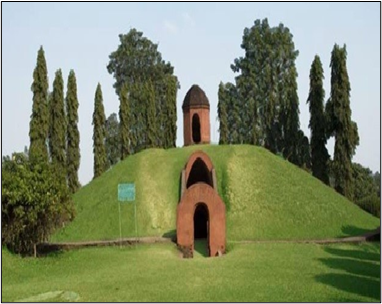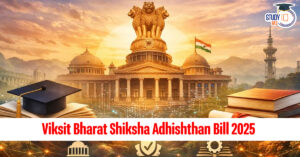Table of Contents
Royal Burial Mounds – UNESCO World Heritage
Context: The Charaideo Moidams were added to the UNESCO World Heritage List.
About Moidams – the Mound-Burial System of the Ahom Dynasty
- The Moidams are linked to the Tai Ahom rulers who migrated from Yunnan, China, and established their kingdom in Assam and ruled the region from the 13th to the 19th century.
- It serves as the royal necropolis of the Tai-Ahom dynasty.
- The site features strategically planted banyan trees and other specific trees used historically for making coffins and bark manuscripts.
- Additionally, artificial water bodies were crafted to complement the sacred ambiance.
- Cultural Significance: These mounds house the remains of kings, royals, and grave goods including food, horses, and elephants. In some instances, queens and servants were also buried here.
- Religious Practices: Traditional Tai-Ahom rituals such as “Me-Dam-Me-Phi” and “Tarpan” are still performed at the Charaideo necropolis, preserving the cultural heritage.

- Architectural Features: The necropolis hosts 90 moidams, which are hollow vaults constructed from brick, stone, or earth.
- These mounds vary in size and structure.
- It features a large underground vault with one or more domed chambers.
- The structure is encased in a large earthen mound, giving it a hemispherical external appearance.
- Atop the mound, a small open pavilion called a chow-chali is positioned.
- The entire moidam is enclosed by an octagonal dwarf wall.
- Location: Charaideo, near the foothills of the Patkai Range in eastern Assam.
| Facts |
|
Puberty Blockers
Context: Tesla and SpaceX CEO Elon Musk has claimed that his transgender child was metaphorically “destroyed by the woke mind virus” after he was “deceived” into agreeing to the administration of “puberty blockers.”
What are Puberty Blockers?
- Definition: Puberty blockers are medications used to delay the physical changes associated with puberty.
- This is particularly relevant for transgender and gender-diverse teens experiencing gender dysphoria, a conflict between their assigned gender at birth and their identified gender.
- Purpose: These drugs are prescribed to pause sex hormone production to alleviate the psychological stress and mental health threats caused by unwanted physical changes during puberty.
How Do Puberty Blockers Work?
- Mechanism: These drugs are gonadotropin-releasing hormone (GnRH) analogues, which inhibit the body’s production of sex hormones.
- For individuals assigned male at birth, they reduce the development of facial and body hair, prevent voice deepening, and limit the growth of the genitals.
- For those assigned females at birth, they halt or limit breast development and stop menstruation.
Other Uses and Prescription Trends in India
- Additional Applications: Besides gender dysphoria, puberty blockers are used to treat precocious puberty, where children experience early-onset puberty.
- Prescription Trends: In India, these drugs are primarily prescribed for precocious puberty. They are also used for individuals seeking gender reassignment surgery, though such surgeries are not performed before the age of 18.
Administration and Side Effects
- Administration: The medication can be administered through injections (monthly, quarterly, or semi-annually) or through an implant in the upper arm, which typically needs replacement annually.
- Side Effects: Possible side effects include insomnia, weight gain, muscle aches, fatigue, mood changes, changes in breast tissue, and irregular periods or spotting. There is also a risk of depression and tendencies towards self-harm.
Examples, Case studies and Data
- State of Energy (GS 3):
- Compliance with Emission Standards: Only 16% of thermal power plants, which totals 98 out of 606 units, meet the emission norms for sulphur dioxide (SO2), a significant pollutant.
- Thermal Plant Capacity Compliance: Only 9% of the total thermal plant capacity assigned to states and union territories adheres to SO2 emission standards.


 Protection of the Aravalli Range: Import...
Protection of the Aravalli Range: Import...
 Viksit Bharat Shiksha Adhishthan Bill 20...
Viksit Bharat Shiksha Adhishthan Bill 20...
 Jumping Genes: The Revolutionary Discove...
Jumping Genes: The Revolutionary Discove...

























